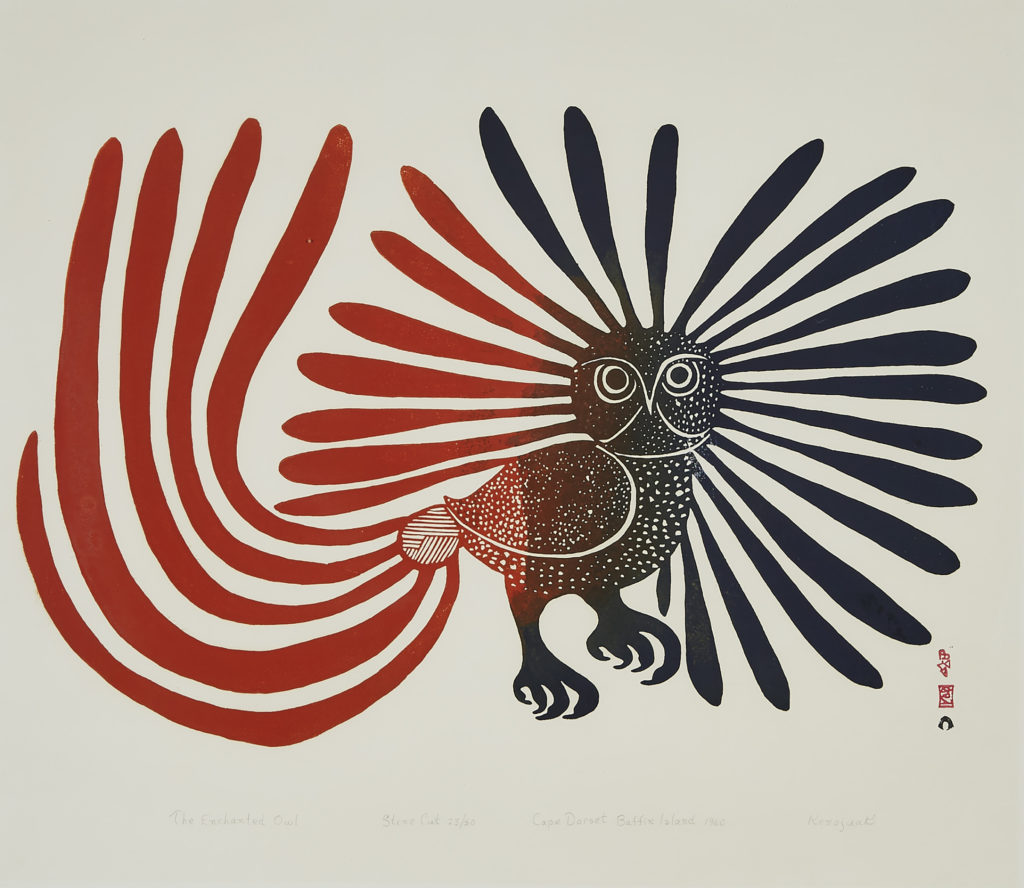Artists’ resale right sparks debate among Inuit art galleries, advocates
Copyright change would give artists or their estates 5 per cent royalty on resales over $1,000
This 1960 stonecut print “The Enchanted Owl” by late Kinngait artist Kenojuak Ashevak sold at Waddingtons Auction House on Nov. 20, 2018, for $216,000. That’s the highest amount ever paid for a print by a Canadian artist at auction, says the Inuit Art Foundation. (Photo courtesy of Waddington’s)
The federal government’s plan to introduce an Artist Resale Right in Canada has drawn both support and criticism, particularly from those in the Inuit art market.
The Artist Resale Right would ensure that when a piece of art is resold through a gallery or auction, the artist or their family receives five per cent of the resale price for artwork worth $1,000 or more.
The provision was announced in the most recent federal budget and still needs amendments to the Copyright Act in order to become official.
Theresie Tungilik, an Inuk artist and past president of the national non-profit Canadian Artists’ Representation/Le Front des Artistes Canadien, said the measure could benefit Inuit artists who rely on their artwork as their primary source of income.
“I only see it as a very positive thing, because many of the artists that have made a name for themselves did so over time as collectors sought their artwork,” Tungilik said.
“This really enhanced the profile of the Inuit artist and the artist community.”
Tungilik used Kenojuak Ashevak’s The Enchanted Owl as an example. In 1960, the first print sold for $75 and Ashevak received approximately $24. In November 2018, a print sold at auction for a record-breaking $216,000, and in December 2024, another print in blue ink sold for $366,000.
“Had she been alive, or had she named an estate or family member to manage her artwork, that money would go to her estate,” Tungilik said.
Some art dealers caution the Artist Resale Right may present practical challenges, especially in the Inuit art market.
John Houston, of Houston North Gallery in Halifax, which specializes in Inuit art, expressed support for it in principle.
“I understand that France has had these resale rights in place for over 100 years. We’re well behind the times on this one,” he said. “And I think this is our opportunity for Canada to walk its talk in terms of reconciliation and reward the genius of Inuit art and their estates.”
But he asked how it would be implemented.
“Who monitors this without creating a huge bureaucracy?” he said.
“Many of these artists have passed on. Who does the payment go to? The estate? But in many cases, identifying that can take a year or more, from my own experience trying to locate families for film rights.”
Houston added that unsigned or illegibly signed pieces are harder to attribute.
Tungilik said if the Artist Resale Right is implemented, Canadian Artists’ Representation/Le Front des Artistes Canadien would appoint a copyright management organization to track and distribute artists’ payments.
She emphasized the importance of artists signing their work to ensure royalties reach them or their estates.
“For many years now, many of the older artists have only been signing their artwork in syllabics. Those are still recognizable, and so that makes it traceable,” Tungilik said.

Theresie Tungilik, past president of Canadian Artists’ Representation/Le Front des Artistes Canadien, says galleries benefit from artists’ work. A resale royalty would ensure artists also share in the profits. (Photo by Charlene Panigoniak/courtesy of Theresie Tungilik)
Mark London, a Montreal-based art dealer specializing in Inuit art, shared other concerns.
He said implementing an Artist Resale Right could unintentionally discourage galleries from buying Inuit art because the resale royalty would act as an extra “tax” on these pieces.
“Most art isn’t bought for resale anyway. It’s for enjoyment,” he said. “Resale happens when someone dies or redecorates. The number of works that sell for big profits is very small. You can’t cherry-pick the Enchanted Owl.”
In 2015, about 13,650 Inuit artists produced visual arts and crafts with roughly 4,230 creating works for income. The sector contributed $87.2 million to Canada’s gross domestic product and supported more than 2,700 full-time jobs across visual arts, performing arts and media, according to the National Indigenous Economic Development Board.
Tungilik acknowledged the concerns but said fair compensation for all Canadian artists is the priority.
On its website, Tungilik’s organization states that both the seller and the art market agent would share responsibility for the royalty payment.
She said galleries raise prices to cover their own operating costs, noting “a gallery selling an art piece for $50,000 when the artist received only $500 — and these northern artists still have to pay their own water bills and rent.”
“Artists are businesspeople too, and if there were no artists, would the galleries exist?”






(0) Comments